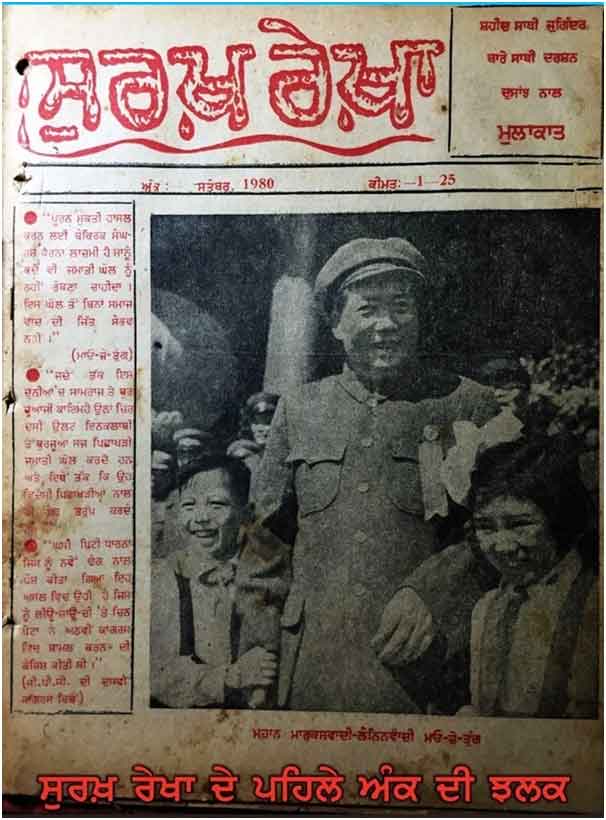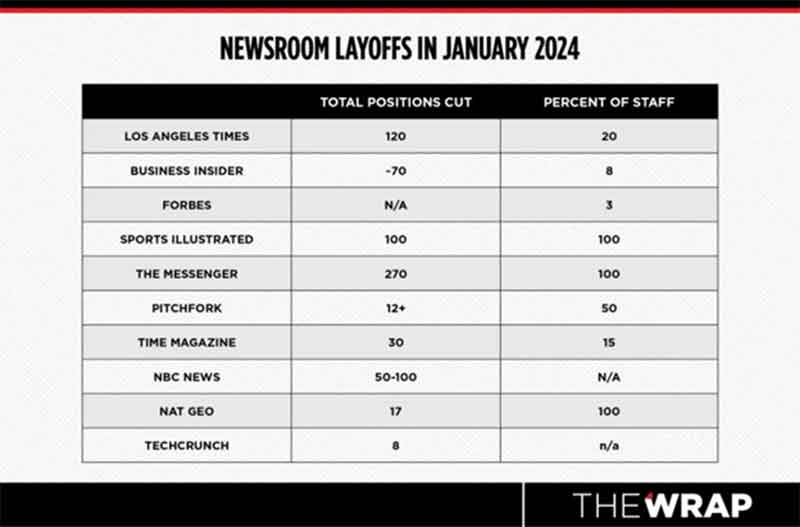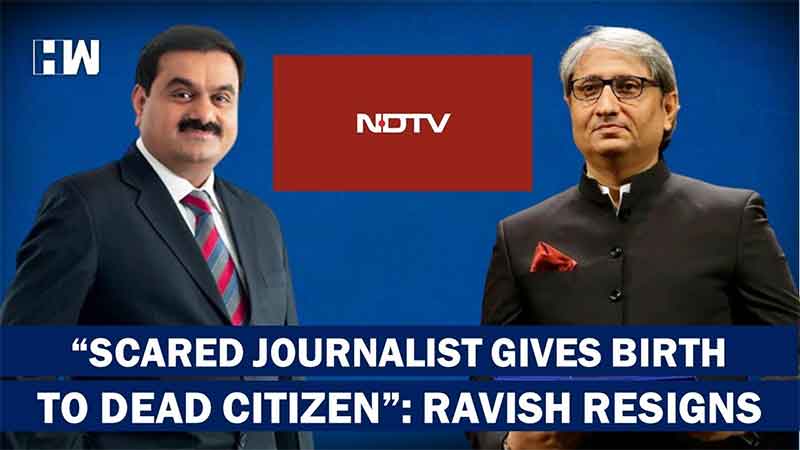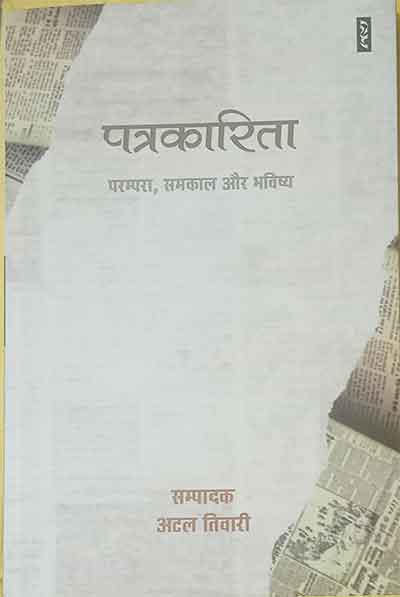
This year earlier on September 1st we commemorated the 40th anniversary of Punjabi journal Surkh Rekha,which was a landmark event in the history of Indian revolution. Originally it was the mass paper of the Central Team C.P.I. (M.L.) It was founded 40 years ago by Nazar Singh Boparai.on September 1st, 1980.No journal in the history of Punjab illuminated the flame of Naxalbari or Mao thought with the intensity of Surkh Rekha.It is the only revolutionary journal ever in India to come out as a weekly and sold in the stands
In its first 22 issues from 1980-82 it brilliantly covered the history of the movement of the Punjab Students Union and Naujwan Bharat Sabha called ‘Fashi rujhawan da mil ke virodh karo.’Very sharply it condemned the Dengist revisionist line in China and tooth and nail defended the formation of the C.P.I.(M.L.)in 1969.No paper was as militant but there were certain left sectarian overtones of characterizing Nagi Reddy line as rightist ,underestimating enemy forces and upholding boycott line as strategic path for Indian revolution. Very authentically it defended the kernel of the Naxalbari line making a critical summary of the left adventurism prevalent in the Charu Mazumdar era.Tooth and nail it called for the re-organization of the whole C.P.I.(M.L.) as established in the 8th Congress in consonance with the line of the Central Team of the C.P.I.(M.L.)
In the era of Khalistani terrorism it confronted Sikh separatist ideology at its hardest core with the sharpness of a sword. It exposed the secrets of the Khalistani movement. It flashed its pages covering heroic armed combat resistance against the Khalistani fascists. However there was one major error in not upholding the revolutionary martyrdom of Comrade Baldev Singh Mann of Chandra Pulla Reddy group at the hand of Khalistani terrorists in September 1986, by classing him as an ally of revisionism and agent of imperialism. .In contrast Inquilabli Jantak leeh of Nagi Reddy group upheld Mann as a genuine revolutionary martyr.
From 1987 a genuine liason was established with the Nagi Reddy group paper Inquilabi Jantak Leeh.They jointly reported struggles and published a joint report on ‘Bleeding Punjab’ which reported the experience of the entire Khalistani movement and resistance by democratic left. It was a virtual encyclopaedia of the various struggles of leftists forces waged against twin terror of Khalistani terror and state terrorism. The most significant contribution was the reports it published on the resistance and conferences of the ‘Front against Repression and Communalism.” like the Moga Rally in July 1987 and the Sewewala martyrs conferences at Faridkot in 1991,1992 and 1993.No paper ideologically exposed the pro-feudal and pro-imperialist essence of Khalistani ideology by dialectically confronting it in its very skin. It projected the cutting edge of the mass revolutionary resistance of the genuine communist revolutionary forces. The unity it established with the “Inquilabi Jantak Leeh ” from the 1980’s will carve out a permanent niche in the joint struggles of 2 different revolutionary papers. Perhaps never in history of Indian revolutionary movement have 2 revolutionary papers worked so closely together or even published joint issues. The unity of Surkh Rekha and Inquilabi Jantak Leeh was a major crystallisation in the Communist revolutionary movement of Punjab.It was an abject lesson of a how mutual cooperation and liason should be established between 2 different mass revolutionary papers in practicing of mass line.
The unity of the Centre of Communist revolutionaries and the Central Team of the C.P.I.(M.L.) had a profound impact on the mutual cooperation between the Surkh Rekha and Inquilabi Jantak Leeh. Eventually both groups merged into the Communist Party Re-Organization Centre of India (Marxist Leninist)which shaped the merger of the 2 journals. In later years after merging with journal Inquilabi Jantak Leeh in 1994 it played an instrumental role in defending massline of Tarimela Nagi Reddy.In 1994 it published the unity declaration of the C.P.R.C.I.(M.L.) and summarized the significance of the unity in context of massline and agrarian revolution. Its pages were full of reports on mass struggles of all opressed sections led by revolutionary mass organizations. For 2 years strong unity was prevalent. Remarkable that a paper defending the Charu Mazumdar line merged with that upholding the Nagi Redy line.
One of the remarkable features of Surkh Rekha was its coverage of the massline struggles and practice of the Bharatiya Kisan Union(Ugrahan),the Punjab Khet Mazdoor Union and the mass platform Lok Morcha.It maintained the distinction of a mass revolutionary paper with an official party organ stressing on the democratic essence of the mass movements. During an election campaign in 1999 it re-published the writings of Shaheed Bhagat Singh.On all the state election campaign s it vividly explained the correct revolutionary tactics of ‘active political campaign in contrast to tactics of ‘participation in parliament’ supported by organizations like Lok Morcha,Punjab Khet Mazdoor Union and later BKU(Ugrahan) .In depth reporting was done on the activities of mass organizations during elections exposing the nefarious anti-people agenda of the ruling class parties and sharpening tentacles of democratic revolutionary alternative. This was in contrast to line of parliamentary participation by New Democracy and Liberation groups and that of ‘Active Boycott by Maoist groups. I was privileged to attend the Pagadi Sammelan rally in 2012 in Barnala as well as attend the intensive preparation campaigns, the election conference in Bathinda at Puda grounds in 2017 and the Raj Badlo Samaj badlo conference in Bathinda in 2019.
With the perspective of a mass revolutionary paper it published a special report on the peasant movement led by the Bharatiya Kisan Union(Ugarhan) in 2007 in English. It summarised the mass line approach where religious politics was combated and democratic functioning introduced. Examples were given of how the BKU(Ugrahan) confronted the mighty Trident MNC at Chattewadh.In Punjabi it published a poetic description of the New Democratic Revolution. In various other struggle reports it reported the manner how under BKU peasants prevented politicians from adressing rallies and how compensation of crores of rupees were overall won by families of suicide victims. The paper also published the struggle reports of the Punjab Khet Mazdoor Union whereby plots were won for agricultural labour in Lambi and Muktsar and thwarting of dalit land being auctioned at Balajhar Vinhu village.It made a systematic analysis of how a revolutionary party had to be created to facilitate the agrarian revolution and gap be wedged between agricultural labour and landed peasantry. In 1994 it vividly covered the historic conference in Rajeana village paying homage to martydom of Bant Singh Rajeana in 1972,by publishing important writings on naxalbari.When the unity of the Communist Re-Organization Centre of India(Marxist Leninist) took place in 1994 with Leninist perspective it summarized the contribution of the unity towards the mass line. Although upholding Tarimela Nagi Reddy it did not completely negate Comrade Charu Mazumdar,and upheld his positive contribution in Naxalbari.Most consistently the paper highlighted the writings of T.Nagi Reddy,Harbhajan Sohi as well as Charu Mazumdar .Surkh Rekha also published special issues covering the Bhgat Singh Centenary where 50000 people were mobilised in September 2007 and on Cultural Comrade Gursharan Singh.The mass political relevance of Shaheed Bhagat Singh and Gursharan Singh were portrayed in light of mass political relevance as distinct from a party line. After the martyrdom of Harbhajan Sohi in 2009 it published a special issue in his memory with messages from nay revolutionary groups and deep biographical sketch. In 2014 it even published a statement of the C.P.I. (Maoist) condemning killing of its cadre and praising the killings being avenged by the people’s army.In a most subtle manner it highlighted and summarized important events of the Chinese revolution led by Chairman Mao like Long March and Cultural Revolution.
Sadly events took downturn and the paper split in 2015 with owner Nazar Singh Boparai launching an ideological tirade against the practice of Surkh Rekha editorial committee. He even claimed that practice of Nagi Reddy influenced mass organizations were devoid of political content. Wrongly he published the paper in his own name as editor, claiming he was the owner. He was openly critical of the stages theory of Nagi Reddy-DV Rao. and advocated that HBS jammed the party. Now Surkh Rekha virtually became the mouthpiece of Nazar Singh Boparai. He even published an open pamphlet claiming that the old team led by Jaspal Jassi most undemocratically ran the paper.Now Jassi’s section functioned under name of ‘Surkh Leeh.’
From 2015 when the paper split editor Nazar Singh Boparai has firm conviction that the movement is making no headway toeing the Nagi Reddy-HBS line, which in his view is class collaborationist.
Boparai has dipped his ink in support of Charu Mazumdar and the Maoist movement in Dandkaranya .In Boparai’s view the Maoist model in Dandakaranya is still a model for Punjab and Comrdae Harbhajan Sohi jammed the party. An open criticism was made of Comrade HBS not holding the party conference and ruling out any discussion on peoples war.
His paper published a series of articles exposing the stages theory of Nagi-Reddy-DV Rao which separated mass movement with armed struggle and tooth and nail upheld Charu Mazumdar.An allegation was made that former Surkh Rekha edited by Jaspal Jassi after the death of Comrade Harbhajan Sohi, virtually made it a mouthpiece of the politics of HBS.
Theoretically he backs the C.P.I.(Maoist) line on analysis of Brahmanical fascism as well as on politics of Punjabi nationality.
Boparai claimed that the line of what is now Surkh Leeh is reformist as well as that of the BKU(Ugrahan)Openly he attacked the BKU(Ugrahan) for negating caste question on dalits ,adopting economist stance on agrarian question and for undemocratic practice.
Consistently he published reports on rallies in Punjab at Barnala and Moga opposing arrest on Urban intellectuals, on state repression in Kashmir and earlier on arrest of professor Saibaba. Several struggle reports of dalit labourer struggles for land rights led by the Zameen Prapti Sangharsh Commitee and the Krantikari Pendu Mazdoor Union were published which support the trends of the C.P.I.(M.L.)New Democracy and the C.P.I.(Maoist) .
Cosmetically Surkh Rekha appears like a mass organ or mouthpiece of the C.P.I.(Maoist) but ironically pro-Maoist forces in Punjab like Lok Sangram Morcha or Krantikari Pendu Mazdoor Union do not back this journal. In recent times no Punjabi revolutionary journal has shimmered the C.P.I. (Maoist) spark so intensely, but in context of Punjab impact has been superficial..We must be critical of his wrong practices but still recognize that he is working hard, and still a component of the revolutionary camp. I would give him credit for publishing in support of protracted people’s war, highlighting anti-caste struggles of democratic organizations and for consistency in condemning Hindutva and state fascism.
Morally it is ‘Surkh Leeh’ which is Surkh Rekha today., which was renamed in September 2015.It was forced to technically function under a new name because of the conspiracy of Nazar Singh Boparai.It most consistently is defending massline being edited by Jaspal Jassi.The consistent tutelage of Jassi was responsible for the continuing of the the glorious tradition of Nagi Reddy and HBS by portraying the proletarian revolutionary line of the Communist Party Re-Organization Centre of India (Marxist Leninist)
Since its founding in 2015 it has defended the genuine mass revolutionary movements and protests against state repression Deep revolutionary democratic approach in crystallizing essence of Mao Thought commemorating 100 years of October Revolution. No mass paper in India has defended mass line of T Nagi Reddy and Hrabhajan Sohi to such a magnitude.
All the democratic revolutionary mass leaders like Bharatiya Kisan Union (Ugrahan) leaders Sukhdev Singh Khokri, General secretary)and Joginder Singh Ugrahan,(President) Punjab Khet Mazdoor Union leaders like Laxaman Singh Sewewala (General secretary)and Zora Singh Nazrali(President) and Nuajwan Bharat Sabha leader Pavel Kusss stood by what was the original ‘Surkh Rekha’ which is now ‘Surkh Leeh.’They firmly feel that it’s practice was correct in terms of adhering to massline.All regularly continued to submit struggle reports to the journal, praising ‘Surkh Leeh’.Many mass revolutionary sympathisers vouched for ‘Surkh Leeh’ and wee very critical of Surkh Rekha of Nazar Singh Boparai.
After technically changing name from ‘Surkh Rekha’ to ‘Surkh Leeh’ in 2015 the most notable contribution has been defending consolidation of revolutionary democratic movement of peasantry for economic and political demands and against state repression.
During 50th anniversary of Naxalbari ‘Surkh Leeh’ explained the essence of Naxalbari revolutionary politics in context of agrarian revolution and re-organization of the Communist party. It covered the issue in 11 parts .The most illustrative or significant parts were on the Unity in the Communist Revolutionaries, The militancy of the people’s movement in Punjab in relation to Naxalite movement, relation of the naxal rebellion with the working class and policy of building base areas in Chinese revolution.
It explained how a movement could only crystallize after political consciousness was instilled in the peasantry and a movement built uniting the landed peasantry with the agricultural workers. A vivid example of how the tea workers united with the peasants in naxalbari struggle was illustrated. In great depth the aspect of how proper mutual political ideological unity had to be carried out and proletarian revolutionary line established for re-organization of the whole party was dealt with. Great stress was placed on development of correct communist revolutionary line and importance of re-organization of the party.
Above all it also upheld the positive contribution of Charu Mazumdar in the section on how Naxalites emerge as symbol of Communist revolutionary movement .The moral contribution of Kanu Sanyal in mass movement was also highlighted.Not slanderingMazumdar or Sanyal was a reflection of mass revolutionary approach in contrast to sectarianism.
Photos of martyrs like T.Nagi Reddy,Charu Mazumdar,Darshan Singh Dusanjh,Harbhajan Sohi,Prithipal Singh Randhawa,and Baba Bhuja Singh were printed which showed the diversity of perpective. In Hindi it published a booklet summarizing the essence of Naxalbari in context of agrarian revolution in a most organized and congeal fashion with most dialectical analysis of united front.. Even pro-Maoist sections admired it.
From 2010 no paper dipped it’s ink so intrinsically in condemning Operation Greenhunt .In 2016 it published a lucid analysis on the qualitative development of the peasant movement of the BKU (Ugrahan) and the parliamentary and collaborationist nature of the joint front of organizations from Punjab participating in rally in Delhi.
It covered the election campaign which it staged jointly with mass papers Lok Kafla and Lal Parcham in January 2017.A detailed report was given on the preparations and speeches in the conference in Bathinda context of mass revolutionary political alternative.
A mammoth tribute was paid to progressive writer Ajmer Singh Aulakh in June 2017 after he passed away and every subsequent year the journal paid commemoration to the departed comrade.
Reports were also published of the front for Dalit Solidarity which held an impactful rally in Bathinda in May 2018.
No revolutionary paper has so consistently projected the history of the mass revolutionary line of Prithipal Singh Randhawa in mass movement, particularly in context of Moga Sangram rally.
Surkh Leeh has projected the democratic revolutionary perspective more than any journal towards the arrest of urban intellectuals.
Fitting with the accordance of the current situation it has published articles upholding the glory of the Chinese Revolution and Socialist China, particularly highlighting great achievements in agriculture, health and education. The legacy of Stalin has also been upheld with an iron fist. During 100 years of October revolution at the very root it touched on how the Russian Revolution was a turning point in the history of mankind in obtaining real democracy.
The note of editor Pavel Kussa is a must for all readers where he praises the Chandigarh protest in September 2018 against black laws and arrest of Urban intellectuals by over 40 organizations as an outstanding expression of the intensity and credibility of the consolidation of democratic revolutionary forces political struggle in Punjab.
Surkh Leeh also gave support to the protest for self determination in Kashmir by publishing a report on the essence of the protest of democrat revolutionary forces of 2 different trends. A most qualitative contribution in recent years was publishing in commemoration of Jallianawallah Bagh centenary in April 2019 and reporting the programmes in Amritsar.
It reported the election programme representing correct trend for broad peasant masses in Bathinda in May 2019 and also the meeting the following day for intellectual section sin Barnala projecting revolutionary alternative.
A detailed analysis was also made condemning the NRC-NPR laws and covering all the important agitations confronting it.
In recent months it has done most commendable work in publishing reports on the organized work of the peasant organization and agricultural labour organization organizing relief during lockdown and exposing how the ruling classes were using Covid-19 crisis to diffuse organized struggles. Reports of state level rallies were made which literally shook the very bones of the ruling class parties.
The paper has published political statements of the Communist Party Re-Organization Centre of India (M.L.) but has asserted that it is a mass political paper and not an organ of a political organization. The most significant party statements published were on revolutionary alternative in election 4 times and in 2015 on peasant movement in Punjab.
What is most commendable of Surkh Leeh is its maintaining the distinct identity of a mass political paper from an official party organ. Even if supportive it does not claim to be an organ of the C.P.R.C.I. (M.L.) Above all it has placed the mass political movement in the correct light giving the mass organizations an independent identity. However perhaps it needs to place greater emphasis on discussing the polemics of Marxism-Leninism-Maoism, particularly in light of protracted people’s war and on analyzing caste question and fascism in Indian context. Maybe it should also project International armed struggles more like in Phillipines and Turkey and discuss some of the important debates within Maoism today through printing publications. Sections of the revolutionary camp from the Maoist trend and that of C.P.I. (ML.) New Democracy class its line as rightists but still admire its ideological consistency and lucidity. In the view of Comrade Jaspal Jassi there should have been a single mass revolutionary paper belonging to all the groups within the revolutionary camp. The latest issue of Surkh Leeh published today is an ample proof of its consistency of mass revolutionary democratic approach acting in perfect harmony with situation prevailing.
Probably it is the inherent weaknesses in the Communist and mass revolutionary movement that made Comrades like founder member of Surkh Rekha Nazar Singh Boparai rebel and also make other comrades too go astray. The divergence of ex-naxalites to path of Sikh militancy is another example .The suicide of late Comrade Satnam who traversed every trend within the Communist revolutionary camp to reject everyone is also an illustration of glaring gap in creative crystallisation of Maoism instead of dogma. When I meet him now I can’t believe I am talking to the same Nazar Singh Boparai who was the first person I ever met from the Surkh Rekha team in 2012, who even gave me a lot of guidance .Infact I have to thank him for supporting me so much by Xeroxing old revolutionary organs of the Central Team and later Nagi Reddy trends of the CCRI and CPRCI(M.L.) later.
Harsh Thakor is an independent writer- [email protected]
SIGN UP FOR COUNTERCURRENTS DAILY NEWSLETTER















































